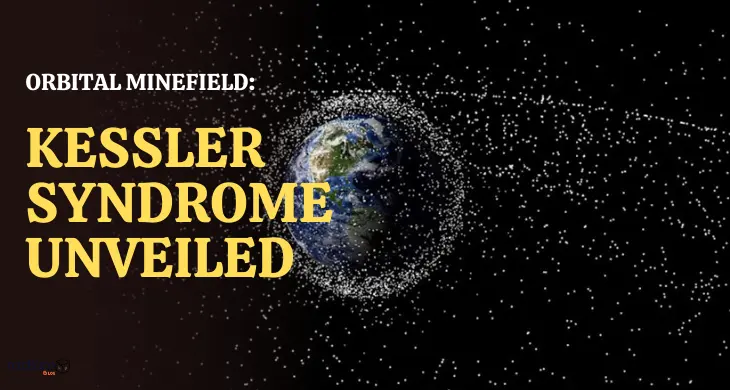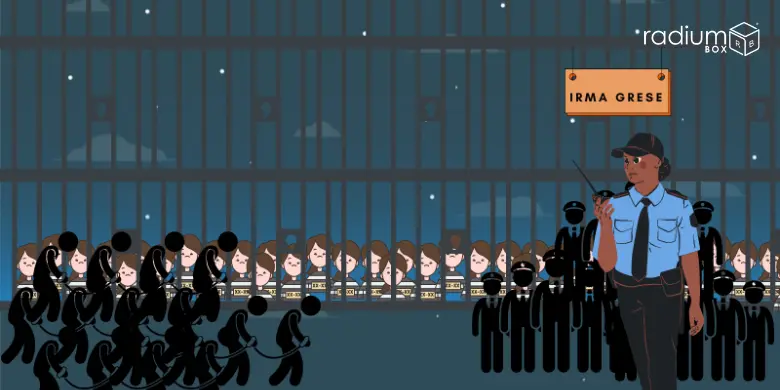The expansive and seemingly tranquil realm of space, embracing Earth in a cosmic dance, is presently transforming into an unforeseen battleground. This celestial arena is shadowed by the ominous specter of the Kessler Syndrome, a phenomenon named after the eminent NASA scientist Donald J. Kessler. This syndrome paints a haunting picture of a potential domino effect, a cascade of collisions among satellites and space debris, posing a grave threat to the equilibrium of our orbital environment.
In this blog, we embark on a journey to unravel the intricate tapestry of the Kessler Syndrome dilemma. It is a narrative that explores the origins of this looming threat, delves into the profound consequences it may unleash upon our cosmic surroundings, and underscores the imperative for urgent and innovative solutions. As we peer into the celestial theater, we will navigate the complexities of this cosmic conundrum, shedding light on the perils that imperil our orbital realm and the compelling need for proactive intervention.
The Orbital Landscape: A Fragile Ecosystem
In the vast celestial expanse surrounding Earth, a breathtaking dance unfolds as satellites traverse the cosmic ballet with grace. This section serves as a gateway into the enchanting intricacies that compose the delicate ecosystem of our planet’s orbits. Imagine a symphony where satellites move in orchestrated synchrony, each playing a crucial role in the cosmic narrative. As we embark on this exploration, the emphasis is on unraveling the nuanced threads that weave together the fragile balance allowing satellites to coexist harmoniously. Picture the intricate choreography of these man-made celestial travelers, navigating the vastness of space in a delicate interplay of orbital mechanics.
However, amid this celestial harmony, shadows loom. The narrative pivots to the growing complexities brought about by the escalating number of satellites, spent rocket stages, and fragments of space debris. The celestial stage, once a theater of elegance, now becomes a potential breeding ground for catastrophe. The proliferation of objects in orbit sets the backdrop for an imminent crisis, a ticking clock where collisions become a foreboding risk. Dive deeper into the narrative, exploring the heightened peril posed by these spaceborne entities, each piece of debris a potential catalyst for chaos. It’s within this narrative that the ominous concept of the Kessler Syndrome takes center stage—a phenomenon where the delicate equilibrium sustaining our celestial realm is jeopardized.
Kessler’s Warning: From Prediction to Reality
Plunge into the prescient insights of Donald J. Kessler, a space visionary whose warnings have transcended the realm of theory, manifesting into a tangible reality. This section is a deep dive into Kessler’s forewarning about the repercussions of a congested orbital environment and a reflection on how his prophetic vision has materialized.As we embark on this intellectual journey, we scrutinize Kessler’s predictions with a keen eye, exploring the evolution of space debris over time. Witness the transformation from theoretical speculation to the stark reality of a crowded celestial arena. What were once cautionary tales have now taken shape as tangible challenges in our quest to explore and utilize space.
The narrative unfolds against the backdrop of an increasingly cluttered orbital space. It examines the relentless growth of space debris, the remnants of human innovation now posing significant threats. Explore the intricate details of this evolution—how satellites, once launched with specific purposes, have transformed into potential hazards as they age and succumb to the harsh conditions of space.Within this exploration lies a vivid portrayal of the challenges posed by the proliferation of space debris.
Cascading Collisions: Unraveling the Domino Effect
In the celestial theater above, a perilous drama unfolds, and this section acts as a spotlight on the intricate and potentially catastrophic phenomenon known as the “Cascading Collisions” or the Domino Effect within the context of the Kessler Syndrome. Imagine a scenario where a seemingly minor collision sets off a relentless chain reaction, akin to the toppling of dominoes, unleashing a cosmic ballet of destruction in Earth’s orbits.
Unveiling the Domino Effect:
This exploration delves into the heart of the Kessler Syndrome, unveiling the inherent domino effect that lies within. Visualize a single collision between satellites or fragments of space debris, acting as the catalyst that initiates a cascading sequence of collisions. Each collision generates fragments, transforming the once orderly and navigable orbits into a chaotic and hazardous debris field.
A Celestial Ballet Turned Chaotic:
As collisions propagate, the celestial ballet transforms into a chaotic dance of destruction. Fragments, like unpredictable dancers, traverse the orbital stage, colliding with other objects in their path. This section provides a vivid portrayal of this cosmic pandemonium, highlighting the stark departure from the ordered and harmonious movements of satellites to a turbulent and unpredictable dance of debris.
Scale and Implications:
Delve into the potential scale of this cascading destruction. Contemplate the implications for existing satellites navigating this increasingly hazardous celestial terrain. The narrative extends beyond the immediate aftermath of collisions, exploring the enduring challenges posed to future space missions attempting to navigate through the remnants of these catastrophic events.
Navigating Chaos: Mitigating the Domino Effect:
Explore potential solutions and technological innovations aimed at restoring order to Earth’s orbits. Contemplate the significance of preventing further collisions and preserving the viability of the orbital environment for future space exploration.
Impact on Orbital Sustainability: A Growing Crisis
In the vast expanse of Earth’s orbits, a growing crisis looms, threatening the very sustainability of our celestial realm. This section illuminates the escalating challenges posed by the proliferation of space debris, examining how this surge imperils the delicate balance that has facilitated human exploration and satellite technology.
Unraveling Orbital Sustainability:
This exploration peels back the layers to reveal the complex and delicate dynamics that underlie the fragility of sustaining orbital environments. It meticulously dissects how the cumulative effect of human endeavors in space disrupts the equilibrium, stressing the resilience of our celestial sphere. This narrative journey offers a profound understanding of the multifaceted challenges posed by our actions in space, spotlighting the critical need for responsible practices to preserve the sustainability of our extraterrestrial realm.
The Delicate Equilibrium at Stake:
This delicate balance, essential for seamless orbital navigation, faces a critical juncture as the celestial landscape grows increasingly congested with space debris and an escalating population of satellites. The very foundation of this equilibrium, which has long enabled the peaceful coexistence and navigation of man-made objects in space, now teeters on the brink of disruption. As this orbital environment becomes more cluttered, the intricate balance that governs the movement of satellites and spacecraft faces unprecedented challenges, raising profound concerns about the sustainability and safety of activities in space.
Satellites as Sentinels:
Contemplate the role of satellites as sentinels, providing critical services ranging from communication to weather monitoring. The narrative dives into the challenges faced by these essential components of our technological infrastructure, highlighting how the growing crisis in orbital sustainability jeopardizes their functionality and longevity.
Navigating the Cosmic Minefield:
As the celestial landscape transforms into a potential minefield, examine the difficulties posed to spacecraft and satellites attempting to navigate through the escalating debris field. Contemplate the risks and complexities associated with sustaining a functional and secure orbital environment amidst the growing challenges.
Mitigating the Threat: Challenges and Solutions
As the threat to Earth’s orbits intensifies, this section delves into the complex landscape of challenges and potential solutions in mitigating the looming crisis. Navigating Technological Challenges:
Embark on an exploration of the technological hurdles inherent in mitigating the threat. Delve into the complexities of developing effective methods for debris removal, satellite tracking, and collision avoidance. Uncover the intricate web of challenges that scientists, engineers, and space agencies must navigate to safeguard the integrity of Earth’s orbits.
Space Debris Removal Technologies:
From innovative robotic systems to harpoon-like devices, this narrative provides insight into the arsenal of tools developed to actively clean up the debris-infested celestial environment. Evaluate the effectiveness and challenges associated with each technological approach.
Regulatory and Policy Considerations:
Understand how international collaboration, guidelines for responsible space activities, and regulatory measures contribute to mitigating the threat. Explore the role of governance in fostering a sustainable and secure orbital environment.
Global Cooperation: The Key to Success:
Contemplate the significance of global cooperation in mitigating the threat posed by space debris. Analyze collaborative efforts between nations, space agencies, and private entities to collectively address the challenges. Understand how shared responsibility and coordinated action are pivotal in ensuring the success of mitigation strategies.
Public Awareness and Advocacy:
Recognize the role of public awareness and advocacy in shaping the narrative around space debris. Explore how educating the public about the consequences of an overcrowded orbital environment fosters support for mitigation initiatives. Understand the importance of public engagement in influencing policy decisions and promoting responsible space practices.
The Future of Orbital Management: Toward Responsible Practices
This section propels us into the visionary realm, exploring the trajectory of orbital management and the imperative of adopting responsible practices for the future. Delve into the evolving landscape of space governance, sustainable utilization, and the collective commitment required to ensure the longevity and health of Earth’s orbits.
Navigating the Evolving Cosmos:
Examine how advancements in technology, international collaborations, and governance frameworks are shaping the future trajectory of orbital management.
The Role of Advanced Technologies:
Explore the pivotal role of advanced technologies in sculpting the future of orbital management. From cutting-edge satellite design to innovative propulsion systems, understand how technological breakthroughs are instrumental in crafting a sustainable and secure orbital environment.
International Collaboration for Orbital Harmony:
Contemplate the significance of international collaboration in fostering orbital harmony. Examine how nations, space agencies, and private entities are coming together to share resources, knowledge, and responsibilities, transcending borders to collectively manage the celestial realm.
Sustainable Utilization of Orbital Resources:
Reflect on the concept of sustainable utilization of orbital resources. Analyze how responsible practices, resource conservation, and strategic planning contribute to creating a balance between human exploration, satellite deployment, and the preservation of the celestial ecosystem.
Governance Frameworks for a New Era:
Delve into the establishment of new governance frameworks for a new era of space exploration. Explore the regulatory measures, policies, and international agreements that guide responsible practices, ensuring a harmonious coexistence between the expanding human presence in space and the preservation of Earth’s orbits.
Frequently Asked Questions:
Q: What is the Kessler Syndrome?
A: The Kessler Syndrome refers to a theoretical scenario in space where an increasing amount of debris in orbit triggers collisions, creating a cascade effect of further collisions, potentially rendering space orbits unusable.
Q: What causes the Kessler Syndrome?
A: It primarily results from the accumulation of space debris, including defunct satellites, spent rocket stages, and fragments from collisions, which can collide with operational spacecraft and generate more debris.
Q: How does the Kessler Syndrome impact space activities?
A: The syndrome poses a significant risk to operational satellites, spacecraft, and the International Space Station (ISS). Increased debris levels can lead to collisions, damaging or destroying operational assets and hindering future space missions.
Q: Can the Kessler Syndrome be mitigated or prevented?
A: Mitigating the syndrome involves strategies such as debris removal, spacecraft maneuvering to avoid collisions, and designing satellites for post-mission disposal. Preventing it requires international cooperation to manage space debris effectively.
Q: How likely is the Kessler Syndrome to occur?
A: While the scenario’s likelihood is debated, the increasing amount of space debris heightens concerns. Preventative measures and responsible space activities are essential to minimize the risk.
Q: What steps can be taken to address the Kessler Syndrome?
A: Initiatives include active debris removal, designing satellites for de-orbiting, stricter regulations for satellite launches, and international agreements for responsible space operations.
Conclusion:
Orbital Minefield: Kessler Syndrome Unveiled, a resounding call echoes through the celestial expanse, emphasizing an urgent plea for collective action and responsible stewardship. The narrative underscores the gravity of the challenges posed by the Kessler Syndrome and delineates a path forward that hinges on three crucial pillars: global collaboration, innovative solutions, and responsible practices. It paints a vivid picture of a future where the fate of space exploration and satellite technology rests on the shoulders of unified efforts transcending national boundaries. The imperative for nations, space agencies, and private entities to join forces becomes paramount, recognizing that the delicate balance of Earth’s orbits is a shared responsibility. The narrative champions the need for groundbreaking solutions, the fruits of human ingenuity, to counter the looming threats posed by space debris.




